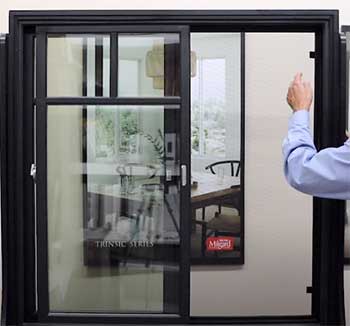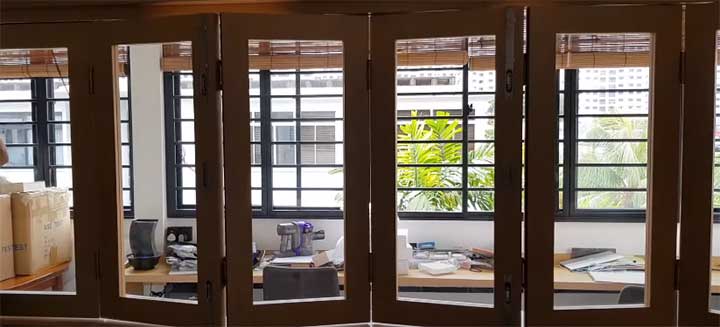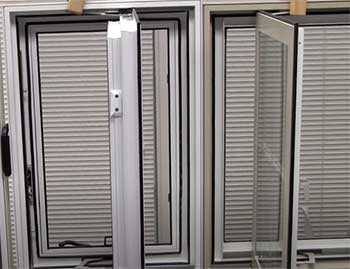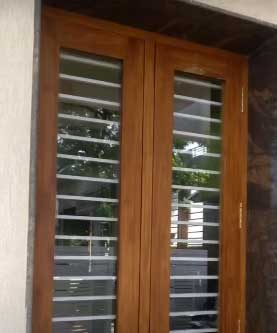If you’re in the market for new windows, you’re likely considering fiberglass and wood options. Both provide advantages over vinyl, but fiberglass and wood have key differences in aesthetics, durability, energy efficiency, cost and maintenance.
This comprehensive guide examines the pros and cons of fiberglass and wood windows to help you make an informed decision for your home.
A Brief Comparison Table
| Factor | Fiberglass | Wood |
| Durability | Excellent, resists rotting, warping, cracking | Good if maintained properly |
| Energy Efficiency | Excellent, similar to wood | Excellent, natural insulation |
| Appearance | More artificial looking | Rich, beautiful wood grain |
| Acoustic Insulation | Good | Superior noise dampening |
| Cost | 20-30% lower than wood | More expensive upfront cost |
| Maintenance | Very low, just occasional cleaning | High, requires refinishing every 2-7 years |
| Customization | Limited to manufactured shapes | Excellent, intricate designs possible |
| Sustainability | Not easily recycled | Renewable and recyclable |
Fiberglass Window Overview

Fiberglass windows, also called composite windows, are made by reinforcing plastic resin with glass fibers.
This makes the materials incredibly strong and durable while still allowing flexibility for window production.
Fiberglass windows first emerged in the 1990s as a lower maintenance alternative to wood.
Today, they’ve become a popular choice for homeowners wanting an attractive, energy efficient and durable window.
Fiberglass Window Pros
- Extremely durable – Fiberglass resists rotting, swelling, cracking and warping better than wood or vinyl. The material won’t chip or peel, providing long-lasting stability.
- Low maintenance – The color and seals are embedded in the frame, so fiberglass windows don’t need frequent repainting or re-caulking like wood. Just occasional cleaning is required.
- Energy efficient – Fiberglass is a good insulator with thermal resistance similar to wood. Frames also block air infiltration well when properly installed.
- Resists insects – Bugs and termites can’t penetrate the hard fiberglass shell. No need to worry about hidden infestations.
- Variety of styles – Fiberglass can be molded into almost any shape, allowing manufacturers to offer plenty of window design options.
- Good value – More affordable than wood or aluminum, with a longer lifespan than vinyl. Fiberglass offers homeowners great bang for their buck.
Fiberglass Window Cons
- Can warp or bow – Poor installation or extreme temperature changes may cause slight distortion in the frame. Proper installation is key.
- Less natural aesthetic – Fiberglass lacks the richness and depth of real wood grain. The surface looks more artificial.
- Heavy glass required – To match wood’s stability, fiberglass windows require heavier, more expensive glass. This increases costs.
- Can’t repair minor damage – Scratches or chips in the fiberglass mean the entire component usually needs replacement.
- Not the best acoustic insulation – Fiberglass doesn’t block sound transmission as well as wood windows. Could be an issue on busy streets.
- Difficult to recycle – Most fiberglass windows end up in landfills. The material isn’t widely accepted at recycling centers yet.
Wood Window Overview

Wood windows are a classic choice valued for their aesthetic appeal, durability and customization potential. Although more maintenance is required, real wood offers unparalleled beauty and character.
Wood windows may utilize several species of wood, the most common being pine, oak, maple and mahogany. Different types provide different levels of stability, durability, staining potential and cost.
Wood Window Pros
- Timeless beauty – Wood offers natural, rich grain patterns that instantly provide style and character. It’s a timeless, sought-after aesthetic for homes.
- Customizable style – Wood can be carved, shaped and molded for one-of-a-kind designs. It also stains well to achieve your ideal color palette.
- Excellent insulation – Wood’s natural density blocks heat transfer and sound transmission better than most window materials.
- Easily repairable – Individual components like the sash and frame can be repaired or replaced as needed. Doesn’t require full window replacement.
- Environmentally friendly – Wood is biodegradable, renewable and recyclable. Most mills now use sustainable forestry practices.
- Adds home value – Wood windows boost resale value more than any other material. Home buyers love their elegance and charm.
Wood Window Cons
- Frequent maintenance – Wood windows require re-painting or re-staining every 2 to 7 years to look their best and prevent deterioration.
- Potential for rotting – Exposed wood can warp, crack or rot without proper moisture protection and maintenance. Areas with substantial rainfall are especially problematic.
- Potential insect damage – Termites, carpenter ants and other insects can damage wood over time if left untreated.
- Air and water infiltration – Wood expands and contracts with temperature and humidity changes. Over time, seals weaken allowing drafts.
- Condensation potential – The warm interior surface of wood windows combined with cold exterior temperatures can lead to problematic condensation.
- High upfront cost – Wood windows are one of the most expensive options. Mahogany and exotic hardwoods increase cost even further.
Fiberglass And Wood: Key Factor Comparisons
Now that we’ve reviewed pros and cons for both fiberglass and wood windows, let’s directly compare the two options across some of the most important factors:
- Durability
Winner: Fiberglass

Fiberglass offers exceptional durability thanks to its composite construction.
It resists rotting, warping, swelling and temperature fluctuations better than wood or vinyl.
Fiberglass won’t crack, chip or peel.
Wood requires diligent maintenance and eventual part replacement to maintain the same structural integrity over decades.
That said, both fiberglass and high-quality wood provide long lifespans. Installed properly and cared for, either choice should last at least 20-30 years under normal circumstances.
- Energy Efficiency
Winner: Tie
Both wood and fiberglass offer excellent thermal resistance. When coupled with optimal glass selections, air sealing and proper installation, they deliver outstanding energy efficiency and keep homes comfortable.
Fiberglass frames have slightly better air infiltration resistance, while wood may have a slight advantage in thermal conductivity. Ultimately though, performance depends more on manufacturing quality and proper installation than the inherent properties of these materials.
Both earn top marks for energy savings.
- Appearance
Winner: Wood
When it comes to aesthetics, nothing beats the richness, depth and elegance of real wood. Fiberglass has a flatter, more artificial appearance that lacks the beauty of wood’s naturally variable grain patterns.
For homeowners who prioritize elegant curb appeal and sophisticated interiors, wood windows are hard to top. If appearance isn’t as important, fiberglass windows still offer clean lines and styles resembling traditional wood windows. But the natural beauty of wood remains unparalleled.
- Acoustic Insulation
Winner: Wood
Wood’s natural density gives it superior sound dampening abilities compared to synthetic materials like fiberglass. Your neighbors won’t appreciate a wood window replacement project, because you’ll hear a lot less outside noise going forward!
Fiberglass windows don’t isolate sound transmission quite as well. If street noise is an issue in your area, wood likely remains the better acoustic insulator. But fiberglass will still muffle exterior sounds better than vinyl or aluminum.
- Cost
Winner: Fiberglass
On average, fiberglass windows are 20% to 30% less expensive than wood windows. The composite material has a lower starting cost, and requires less frequent maintenance and part replacement over its lifetime.
There’s substantial overlap though, with premium fiberglass nearing the low end of wood pricing. But dollar for dollar, fiberglass offers better overall value, keeping installation and long-term costs lower.
- Maintenance Requirements
Winner: Fiberglass
Avoiding maintenance is a major perk of fiberglass. The color and seals are embedded directly into frames, eliminating the need for re-staining, painting, or caulking. Just occasional cleaning is required.
Wood windows are beautiful, but they require commitment. Every 2 to 7 years they’ll need sanding, re-staining or painting, and potentially seal replacements. Fiberglass saves you this regular headache.
- Customization Potential
Winner: Wood
Wood windows’ malleability lends them beautifully to custom designs. Skilled carpenters can shape and mold wood into truly one-of-a-kind pieces matching your personal style. Fiberglass customization relies only on what manufacturers offer.
For intricate architectural details, unusual shapes or sizes, or matching a unique aesthetic, wood remains the best bet. Fiberglass offers more options than vinyl, but wood wins for pure customization.
- Sustainability
Winner: Wood
Wood is widely considered the most environmentally friendly window frame material. It’s biodegradable, renewable when sourced responsibly, and easier to recycle than composites. Fiberglass windows typically end up in landfills.
Both materials can contribute to green building. But wood windows offer eco-conscious homeowners added peace of mind about sustainability from start to finish in their window’s lifecycle.
Fiberglass And Wood Windows: Which Is Right For You?
We’ve covered several key comparisons, but which material is ultimately right for your home? Here are a few final considerations:

- Climate – In wet, humid climates with heavy rainfall and substantial temperature and humidity fluctuations, wood windows require meticulous maintenance to prevent rotting and infiltration issues. Fiberglass is more impervious to moisture and makes more sense in these regions.
- Noise – If exterior sounds like street traffic pose an issue, wood windows provide better noise reduction than fiberglass. This is especially worthwhile for bedrooms and home offices.
- Budget – Fiberglass costs less upfront and over time. If budget is a major factor, fiberglass provides long-term value. For a premium aesthetic on a budget, vinyl-wrapped fiberglass mimics wood at the lowest cost.
- Design styles – For contemporary homes valuing clean lines or minimalist aesthetics, fiberglass aligns well. For traditional, Victorian, farmhouse, or arts and craft designs where wood windows lend authenticity, it’s worth the added investment.
- Eco-consciousness – Homeowners wanting to minimize environmental impact will appreciate renewable, recyclable wood. But both materials can contribute to green building.
Ultimately, choosing wood vs fiberglass windows comes down to your priorities. If cost and low maintenance are most important, fiberglass is the clear choice.
But if you value design aesthetics, custom shapes, green building, and don’t mind the added commitment of wood, then the beauty and character of real wood may be worth the investment.
Frequently Asked Questions (FAQ)
Still unsure which material is best for you? Here are answers to some common questions homeowners have about fiberglass and wood windows.
There’s no universally “better” option. Fiberglass is much lower maintenance, more resistant to weathering and moisture, and costs less long-term. But wood provides superior aesthetics, customization and eco-friendliness. You can’t go wrong with either material. Choose based on your needs and home style.
The tradeoffs with fiberglass windows are less natural curb appeal, sound insulation and customizability compared to wood. Repairs are more difficult, minor damage may require full component replacement, and disposal options are limited. But fiberglass makes up for this with extreme durability and no maintenance beyond occasional cleaning.
No, fiberglass windows are substantially less expensive than wood, by about 20% to 30% on average. The composite material costs less to manufacture at scale. And over their lifespan, fiberglass windows save owners money by avoiding frequent maintenance and repairs.
This depends on your budget and priorities. Fiberglass costs more than vinyl but less than wood or aluminum. Many homeowners do consider the increased durability, energy efficiency and longevity of fiberglass worth the modest premium over basic vinyl windows. Just don’t expect major savings over quality wood windows.
The Bottom Line
Ultimately, both fiberglass and wood windows are outstanding choices that will serve your home well for decades to come. Fiberglass prioritizes durable low maintenance construction, while wood provides unparalleled aesthetics and customization.
Carefully examine your budget, design preferences, climate and needs to select the right material for your household. And be sure to hire experienced professionals for window installation to guarantee you achieve the energy efficiency and performance you expect from these high-quality products.
Your home will look and feel better than ever with new fiberglass or wood windows designed specifically for you.

Appreciate the comments on climate, design, budget, noise, and ecology aspects.